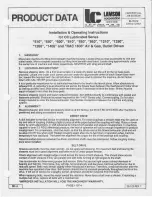
2
3327-951
•
Let the engine and the snowthrower adjust to the
outdoor temperature before starting to clear
snow.
•
Operating any powered machine can result in
foreign objects being thrown into the eyes.
Always wear safety glasses or eye shields while
operating, adjusting, or repairing the
snowthrower.
Operation
•
Do not put hands or feet near or under rotating
parts. Keep clear of the discharge opening at all
times.
•
Exercise extreme caution when crossing gravel
drives, walks, or roads. Stay alert for hidden
hazards or traffic.
•
Do not attempt to clear snow from a crushed-rock
or gravel surface. This product is intended for use
only on paved surfaces.
•
After striking a foreign object, stop the engine,
remove the ignition key, thoroughly inspect the
snowthrower for any damage, and repair the
damage before operating the snowthrower.
•
If the unit should start to vibrate abnormally, stop
the engine and check immediately for the cause.
Vibration is generally a warning of trouble.
•
Stop the engine whenever you leave the
operating position, before unclogging the
discharge chute, and when making any repairs,
adjustments, or inspections.
•
When cleaning, repairing, or inspecting, make
certain that the rotor blades and all moving parts
have stopped.
•
Do not run the engine indoors, except when
starting it and for moving the snowthrower in or
out of the building. Open the outside doors;
exhaust fumes are dangerous.
•
Do not clear snow across the face of slopes.
Exercise extreme caution when changing
direction on slopes. Do not attempt to clear steep
slopes.
•
Never operate the snowthrower without proper
guards, plates, or other safety protective devices
in place.
•
Never operate the snowthrower near glass
enclosures, automobiles, window wells, and
drop-offs without properly adjusting the snow
discharge angle. Keep children and pets away.
•
Do not overload the machine capacity by
attempting to clear snow at too fast a rate.
•
Look behind and use care when backing up with
the snowthrower.
•
Never direct the discharge at bystanders or allow
anyone in front of the unit.
•
Never operate the snowthrower without good
visibility or light. Always be sure of your footing,
and keep a firm hold on the handle. Walk; never
run.
Maintenance and Storage
•
Check all fasteners at frequent intervals for
proper tightness to be sure that the equipment is
in safe working condition.
•
Never store the machine with fuel in the fuel tank
inside a building where ignition sources are
present, such as hot water and space heaters
and clothes dryers. Allow the engine to cool
before storing in any enclosure.
•
Always refer to this operator’s manual for
important details if the snowthrower is to be
stored for an extended period.
•
Maintain or replace safety and instruction labels
when necessary.
Toro Snowthrower Safety
The following list contains safety information specific
to Toro products or other safety information that you
must know.
•
Rotating rotor blades can injure fingers or
hands. Stay behind the handles and away from
the discharge opening while operating the
snowthrower. Keep your face, hands, feet, and
any other part of your body or clothing away
from moving or rotating parts.
•
Before adjusting, cleaning, repairing, and
inspecting the snowthrower, and before
unclogging the discharge chute, stop the
engine, remove the key, and wait for all
moving parts to stop.
•
Use a stick, not your hands, to remove
obstructions from the discharge chute.
•
Before leaving the operating position, stop the
engine, remove the key, and wait for all moving
parts to stop.
•
Do not wear loose-fitting clothing that could get
caught in moving parts.
•
If a shield, safety device, or decal is damaged,
illegible, or lost, repair or replace it before
beginning operation. Also, tighten any loose
fasteners.
•
Do not smoke while handling gasoline.
•
Do not use the snowthrower on a roof.
•
Do not touch the engine while it is running or
soon after it has stopped because the engine
may be hot enough to cause a burn.
•
Perform only those maintenance instructions
described in this manual. Before performing any
maintenance, service, or adjustment, stop the
Summary of Contents for Snow Commander 38601
Page 12: ......






























